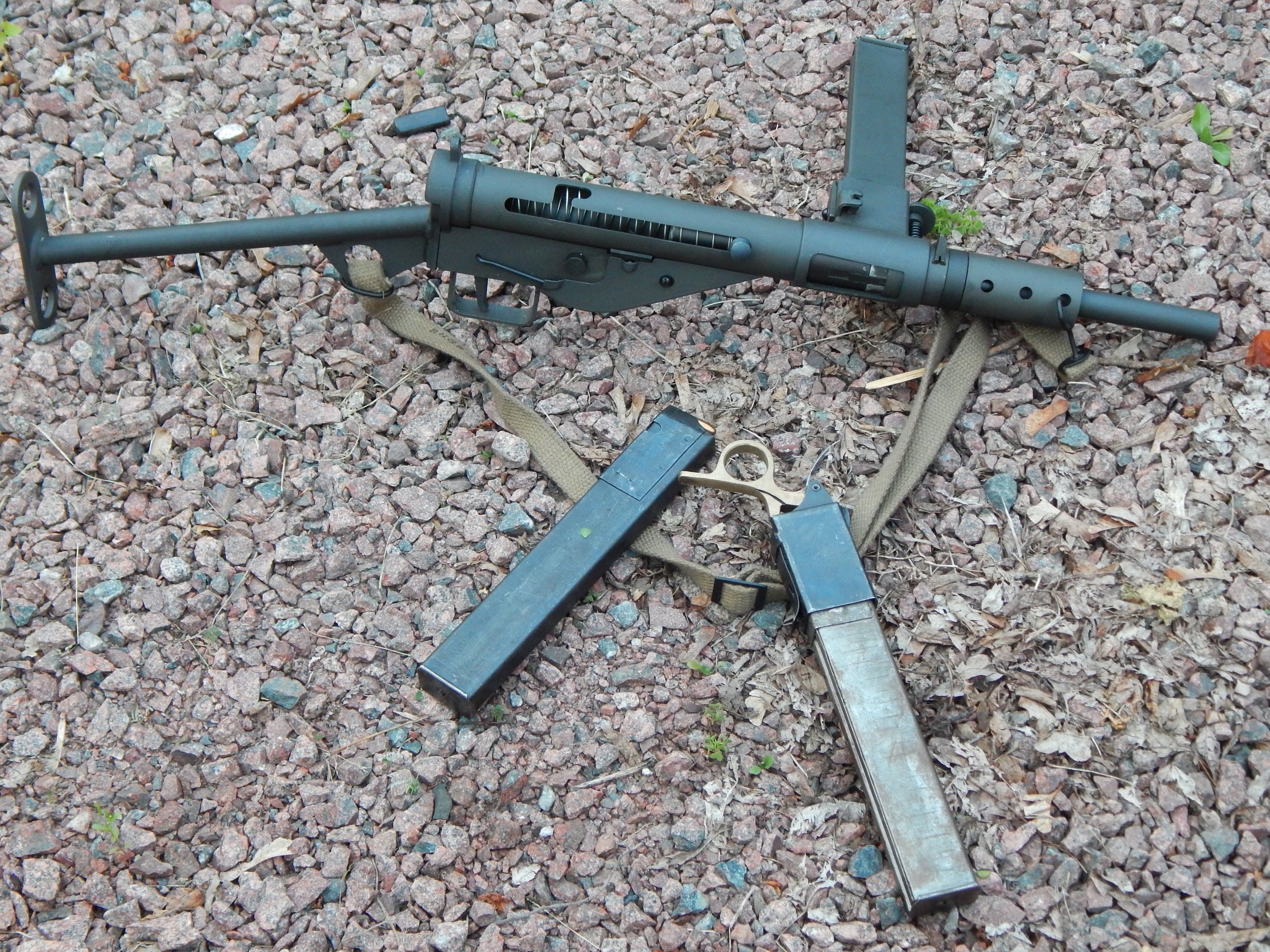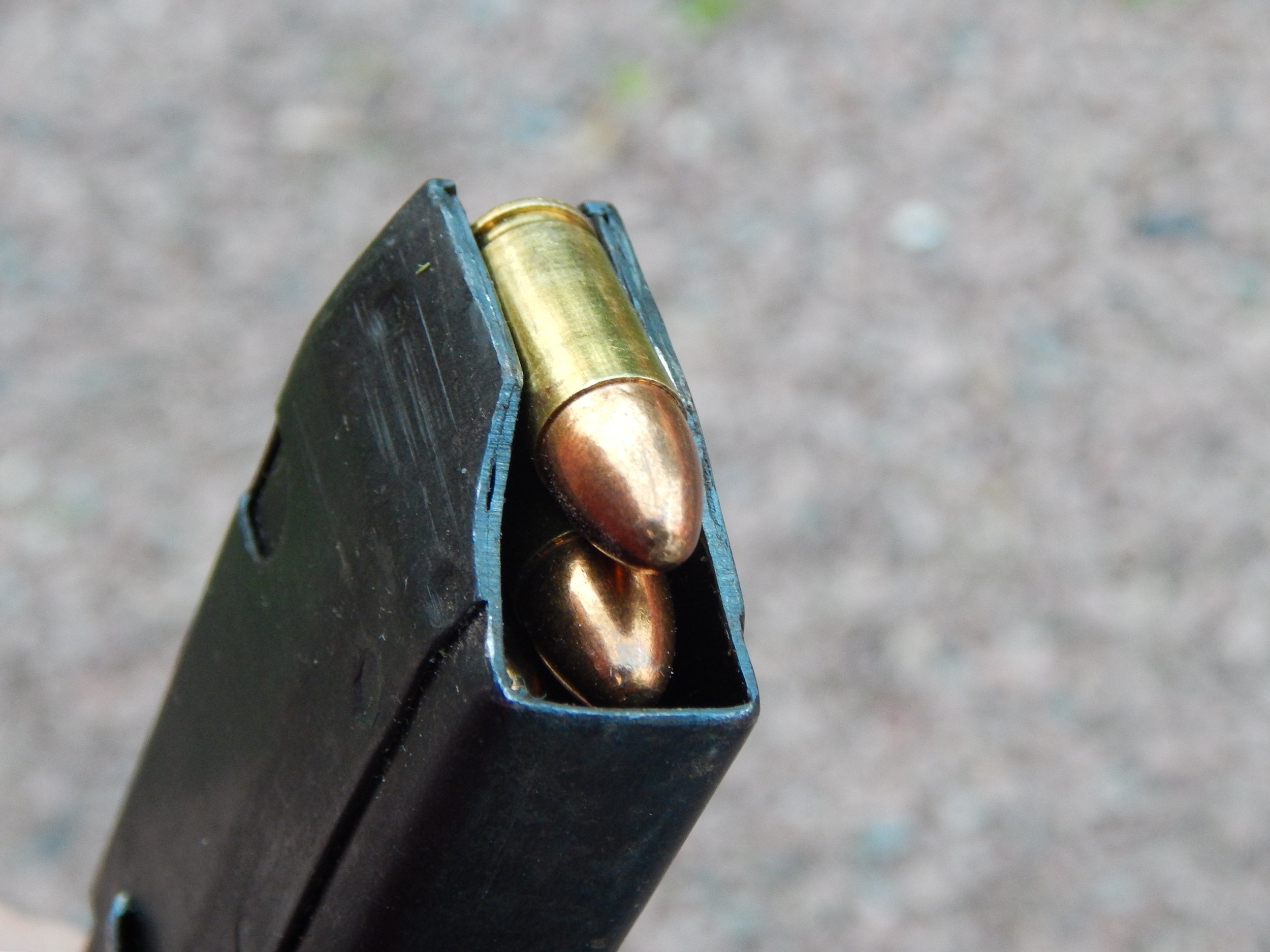Replica: Sten Mark 2
The British Sten Gun was an extremely simple stamped steel submachinegun developed as an inexpensive replacement for the existing Lanchesters in service in the early phases of the Second World War. The Mark II variant would go on to be the most produced and iconic variant of the weapon, and a replica example is shown here.
The History
In the aftermath of the Great War the British had observed the effectiveness of the German MP18 submachine gun, but failed to explore a domestic design until after the Second World War had already commenced. Again observing the effectiveness of such weapons in German hands, in the aftermath of the evacuation of Dunkirk and the subsequent Fall of France the utility of such a weapon became apparent.
The rear sight of the Sten Mk2; consisting of a simple, non-adjustable aperture
The first design was essentially a copy of the MP18, designated the Lanchester. Indeed, even the German 9x19mm cartridge was retained, with the bonus of being able to use captured munitions. Despite this weapon being available, it was expensive and time consuming to manufacture, and post-Dunkirk Britain was in desperate need of a cost-effective solution. Thompson submachine guns were also purchased from the United States, but these suffered from many of the same issues with procurement as the Lanchester, making it clear that a domestic solution was optimal.
Enter Reginald Shepard, an officer of the British Army who served as Inspector of Armaments for the Ministry of Supply, and Harold Turpin, who worked in the design department at the Royal Small Arms Factory, Enfield. After a rapid design cycle a prototype was ready in just over a month, and adopted by the British Army as the Sten Mk1, the name being an amalgamation of Shepard, Turpin, ENfield.
The front sight is as simple as the rear, being a simply wedge dovetailed into the front of the receiver
About 100,000 of these MK1 guns would be produced, but soon it was apparent that the weapon could be simplified further. The wooden stock was replaced with a simple steel strut, foregrips disappeared along with the flash hiders, and thus was born the Sten Mk2. This would become the most common and iconic variant of the weapon, with a total of over two million units produced.
Despite a lack of elegance in the design, the Sten did exactly what was asked of it, that being to be an extremely cost effective design that could be produced in large quantities by dispersed industry. Their first official action came in 1942, when Canadian forces carried Stens during the infamous Dieppe Raid, and despite some reliability issues would remain in service with the British and Imperial forces throughout the war.
The controls of the Sten are a simple notch safety which prevents the bolt from dropping when the trigger is depressed. Also visible beneath it is the selector switch, with the “A” for “Aimed” (semi-automatic) visible. On the other side the letter “R”, for “Rapid” is stamped
The Mk2 would be followed by an even simpler Mk3, and in 1944 the Mk5 entered service, now featuring a wooden stock, pistol grip, foregrip, improved sights and a bayonet lug, reflecting the improved situation at home by that stage of the war. Suppressed versions were also produced for issue to British commando units. The weapon would in the end be produced in Britain as well as Canada and Australia among others, and large numbers would also be produced by cottage industry in Occupied Europe during the war to arm resistance fighters. The weapon was even copied by the Germans at the end of the war, with their MP3008 essentially being a Mk2 with its magazine positioned under the receiver in a manner akin to the MP40.
After the war, the Sten would remain in service for some time, before eventually being replaced with the Sterling submachine gun in the 1950s. The weapon was entirely phased out by the mid 1960s, although it remained in service around the world for some time after.
With the magazine well rotated for transit, the markings are clearly visible. Also visible is the bolt handle lock, depressed to pass through the receiver and lock the action closed
The Design
The Sten is about as simple a design as can be found. At its core the weapon is a steel tube, with a brutalisticaly simple blowback mechanism inside of it. The large, milled steel bolt is actuated via a large spring, with a milled striker detonating the primer when it slams home. The Sten is a select fire weapon, with both a semi-automatic mode and a fully automatic mode with a 500 round per minute rate of fire. This is actuated via a simple push-through button on the trigger housing, marked “A” for “Aimed” and “R” for “Rapid”. The safety is a simple notch that holds the charging handle and bolt to the rear, akin to that on the German MP40.
The Achilles’ heel of the Sten and several of its contemporaries, its double-stack, single feed magazine. This arangement often led to feeding malfunctions
The barrel of the Sten can be removed easily by simply unscrewing the barrel bushing, a simple catch needing to be pulled to release it initially. The same catch also allows the magazine housing to be rotated around the receiver, allowing the gun to lay flat for transport, as well as serving as a dust cover for the mechanism.
Several variations of stocks existed as well, with the strut type being among the most common and most reviled. A skeleton stock made from a loop of steel was somewhat more comfortable, and the later Mk5 included a wooden buttstock essentially taken from the No4 Mk1 Lee Enfield Rifle. The sights are fixed and about as simple as they come on the Mk2, consisting of a simple fixed aperture rear and a wedge dovetailed into the receiver serving as a front sight.
A demonstration of the magazine loader, which is needed to fully load the 32 round magazines in part due to the single feed design mandating a heavy spring
Perhaps the most distinctive feature of the Sten is its side mounted magazine. Containing up to 32 cartridge of 9x19mm Parabellum, the magazine itself is basically a simplified copy of the German MP40’s, complete with its problematic tapered double-stack/single feed magazine, although they were not interchangeable. The side mounted design was a holdover from the MP18 and Lanchester, favored by the British due to it making the weapon easier to operate from a prone position.
The modern markings of the airsoft gun are nicely concealed, only visible when the magazine housing is rotated into the storage position
The Replica
Due to the extremely high price of fully-automatic firearms in the United States, the author has a replica as seen here. In this case it is actually an airsoft gun manufactured by Northeast Airsoft of the Republic of China (Taiwan). The author has, however, handled authenitic Stens in private collections in the past, and can report that the replica is about as close as one can hope to be to the real weapon. Construction quality is very good, with real steel being used, and the airsoft mechanism is contained entirely within the bolt, allowing true open-bolt blowback operation just as with the original. The barrel is sleeved with a smoothbore brass tube but us outwardly of the proper dimensions, and the magazine is likewise designed to hold gas and BBs. Markings are well replicated for a mid-war Long Branch weapon, even though most Long Branch Stens featured the skeleton stock. Two original magazines are also seen here, as these are readily available, as is 9mm ammunition. An original magazine loader is also pictured.
The replica disassembled, coming apart exactly as the real Sten would. Note the plastic chamber cover on the barrel, as well as the BB feed lips on the magazine. The airsoft mechanism is concealed within the bolt
In the opinion of the author, the Northeast Sten Mk5 is probable the best replica money can buy. The author hopes to purchase their Mk5 offering as well in the future.
A Canadian fusilier in action near Caen in 1944, armed with a Sten Mk2
Observed Values and Frequency
Updated: February, 2024
AVERAGE VALUE (USD): $500
FREQUENCY: Production
COLLECTOR’S NOTES: As a replica airgun, these remain in current series production.










